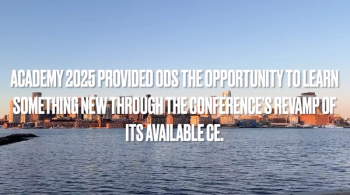
VEW 2022: Simple management for keratoconus
John D. Gelles, OD, FAAO, FIAOMC, FCLSA, FSLS, FBCLA, discusses his presentation titled"Keratoconus 1, 2, 3: simple management," during Vision Expo West.
John D. Gelles, OD, FAAO, FIAOMC, FCLSA, FSLS, FBCLA, director of the Specialty Contact Lens Division of the Cornea and Laser Eye Institute - CLEI Center for Keratoconus in Teaneck, New Jersey, speaks with Optometry Times®' Alex Delaney-Gesing on highlights from his discussion titled, "Keratoconus 1, 2, 3: simple management," presented at the 2022 Vision Expo West meeting in Las Vegas, Nevada.
Editor's note: The transcription below has been lightly edited for clarity.
Could you share a highlights version of your presentation?
So “Keratoconus 1-2-3” is really all about the comprehensive management of keratoconus. We know that the management of keratoconus has changed with the FDA approval of corneal collagen cross linking. And it has allowed us to really open up options for patients because now we can stop the disease. So now we can really comprehensively manage their vision.
What “1-2-3” refers to is the steps in the process of management. Step 1 is stopping their progression. So that's the use of corneal collagen crosslinking.
Step 2 is coming down to the surgical management of an individual where we can reshape their cornea by various different means, such as using laser techniques or implants to get a more symmetric corneal curvature. And then
Step 3 is really getting those individuals vision which could be by glasses, contact lenses, or even in some cases, surgical intervention, like using an [implantable collamer lens] (ICL).
So that's really the idea here: addressing the comprehensive visual needs of these patients. Because so often bosses and optometrists … we think contact lenses takes care of everything. But what about when those patients take their contact lenses off? They still need to be able to function, and many of these individuals don't.
So using this comprehensive approach will bring patients much, much better qualities of life so that they can function throughout their day when they're not wearing their lenses.
You briefly touched on this, but why is this such an important topic of discussion?
This comes down to really addressing the needs of our patients in a better, more comprehensive way. We do an excellent job with specialty contact lenses, but so often we have these patients who just, frankly, are not functional when they're not wearing their lenses. And we know that just based on watching individuals over time, the complications that can arise when we're wearing contact lenses for, say, 18 hours a day.
We can end up having various different things happen to eyes that, unfortunately—for people with keratoconus—if they are entirely reliant on their contact lenses, when they have a problem, it's a real problem. They're now not functional. We really need to try to preserve these cases and keep them healthy and in their contact lenses for a long period of time.
So if we can use other techniques to allow them to wear glasses when they're at their house, or to give them functional, non-corrected vision and keep them out of their contact lenses for that period of time. We can extend the life that they can wear their contact lenses and just provide better overall care for these individuals.
What are the key takeaways?
So kind of twofold on this. The main one is the modern management of keratoconus, which, if we talk with Barry Eiden, OD, FAAO, or any of the other guys from the International Keratoconus Academy, you're looking at the mantra: diagnose early, stop progression, and then rehabilitate vision.
And the other side of this is what I'm going to be really presenting on, which is the comprehensive visual management—step 1: stop progression; step 2: recontour the cornea; and step 3: correct their vision.
So, this should be a really good comprehensive thing that should be pretty easy to follow for most individuals and, so long as you have the equipment. And it should, really, provide a better higher level of care for the keratoconus population. So a win-win overall.
Newsletter
Want more insights like this? Subscribe to Optometry Times and get clinical pearls and practice tips delivered straight to your inbox.













































.png)


